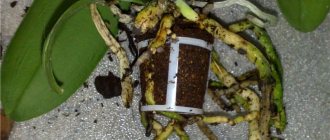Plant overheating
Without understanding why orchids dry out, you need to remember that hanging a flower for a long time on a window that is located on the sunny side of the house, or staying close to a powerful heating radiator can trigger the wilting process.
This is due to the fact that the orchid begins to lose moisture, its roots weaken, as a result of which the leaves of the plant begin to turn yellow and the flowers begin to fall off. You need to protect your green friend from direct sunlight and prepare a more suitable place for him to stay.
Leaves and flowers wither due to disease
Leaves and flowers withering due to disease are a common problem. Let's look at what the most common diseases are, as well as methods of treating them.
- Leaf burns. Their cause is improper lighting or direct sunlight. It manifests itself in the withering of leaves, as well as the appearance of brown, yellow and even black spots. The solution to the problem is to move the flower to a place where it will not receive direct sunlight. When organizing artificial lighting, use cold-glow lamps that are installed at a distance of more than 30 centimeters from the leaves. The affected areas of the vegetative mass should be cut off with a sharp, disinfected object and treated with ground cinnamon or crushed activated carbon.
- Damage from harmful insects and pests. Very often, the plant is affected by colonies of mites that feed on plant sap, which leads to wilting of the leaves. The most dangerous are colorless and red. The reason for their appearance is low humidity, since these insects love very dry air. To solve the problem, the plant is treated with fungicides. The affected areas of the leaves will have to be cut off and treated with ground cinnamon or brilliant green. If the root system is not affected, then the flower does not need to be replanted.
- The leaves (especially the lower ones) are wrinkled or swollen. All this indicates insufficient watering. The problem will be solved if it is normalized. Additionally, give the orchids a warm (temperature about 30-40 degrees) shower every four to five days for a speedy recovery.
- Anthracnose. The disease consists of a fungus attacking the leaves. It appears as round spots of black or brown color. If left untreated, holes will appear in the leaves. The main causes of anthracnose are improper watering and high indoor humidity. For treatment, you need to trim the affected areas using a sharp, disinfected device, and treat the cut areas with ground cinnamon or crushed activated carbon. In addition, you can use various preparations with a high copper content to spray the plant every ten days (three times in total is enough).
- Bacterial spotting. Reasons: too bright lighting, excessive watering. The disease manifests itself in yellowing, darkening, and over time, softening of the leaves and the appearance of cracks and sores with liquid on them. The leaves become sticky. The solution to the problem is to trim the affected areas using a sharp, disinfected device, and treat the cut areas with iodine or crushed charcoal. There is no need to use professional medications, with the exception of damage to the lobar vein.
- Rust. The disease is quite rare, but very dangerous. Treatment is possible only if the disease is detected at the primary stage. Rust (essentially a fungus) manifests itself in the appearance of reddish areas and spores on the leaves. The solution to the problem is to trim the affected parts of the leaves and treat the cut areas with crushed activated carbon. Additionally, you can use professional preparations (Mikosan, Ridomil, Skor, Topsin-M) to spray the plant every ten days (no more than three times in total).
- Sooty, or black, mushrooms. The reason for their appearance is damage to the plant by white scale insects or mealybugs. The fungus can be found in the axils of the leaves. It weakens the leaves and they wither. If nothing is done, the orchid will die. To fight, you should use professional means (“Topsin-M”, “Skor”, “Ridomil”). Using the selected preparation, the plant is sprayed every 7-10 days, but no more than five times in total. Areas of leaves affected by fungi and insects must be trimmed (remember that the tool must be sharp and disinfected, and then the cut areas must be treated with ground cinnamon or crushed charcoal).
From the video you can learn a little more about orchid diseases and methods of treating them.
Shock
A change of habitat always causes stress for the plant. This is similar to acclimatization in humans.
New living conditions, a different level of humidity in the room, a different temperature regime - all this is a real shock for the orchid. The plant reacts to such innovations by shedding buds and flowers. This is absolutely normal. Any living creature needs time to adapt, and an orchid is no exception.
What to do if the orchid roots themselves are damaged
If the trunk of the plant sits firmly in the pot, then the root system of the orchid is not damaged. Quite the opposite if this is not the case.
A healthy root is green. If the root is still young, then its color is slightly lighter green. The rotten root is dark brown in color.
The orchid has withered, what should I do? In order to prevent the plant from dying, it will be enough to simply carefully cut off the rotten roots with a special sterile knife, or you can use ordinary scissors for this. And transplant the plant into another substrate.
Lack of light
The orchid is afraid of direct sunlight, but loves light. An insufficient amount of it provokes the process of withering of flowers.
The plant must be kept in a sufficiently lit place, especially in winter, when daylight hours are reduced. It is advisable to purchase a phytolamp if the lighting in the apartment does not meet the needs of the flower.
Hypothermia of a flower
You may be interested in: Hibiscus diseases: types and descriptions, features of care and treatment
This is most often encountered by people who purchased the plant in winter. After purchasing the flower, they take it home, and if the temperature outside is sub-zero, it is likely that the orchid’s flowers will wither within a few days, which is why it is recommended to cover the plant.
The same applies to drafts; the orchid does not welcome them. When ventilating, the best option would be to move the plant to another room.
How often to water an orchid at home
There is no clear answer to this question. It all depends on a combination of factors and conditions in which the plant is kept. Watering is affected by the time of year, air humidity, room temperature, and the condition of the root system.
There are several recommendations that you should follow when wondering how often to water an orchid at home:
- Better less often, but more abundantly, than vice versa.
- The water temperature should be slightly above room temperature.
- It is preferable to water the flower in the morning.
- Protect the flowers of the plant from water.
- Plant roots should be kept in water for no more than half an hour.
- There should be no liquid remaining in the pot; it should drain completely.
- Water should not contain foreign impurities.
In order to find out whether an orchid needs watering or not, you need to slightly rake the substrate in the pot. If it is wet, no procedure is required. The roots of the plant also indicate its necessity - if they begin to acquire a light shade, you immediately need to water the flower. If the roots are deep green, no watering is required.
For the procedure, tap water is usually used, which is left to stand for three days. It is advisable to purchase a filter and pass liquid through it for the orchid, since soft water has a beneficial effect on the condition of the plant.
In summer, the orchid is watered several times a week; in winter, once is enough. During the flowering period, the flower should be moistened every 3 days.
It is worth recalling that excessive amounts of moisture can cause the orchid roots to begin to rot. The plant tolerates short periods of drought quite easily, but this should not be abused. Insufficient moisture leads to drying of the rhizome and death of the flower.
How long does flowering last?
Having bought an orchid with blooming flowers in a store, it is not immediately clear how long the process has already lasted and how much is left. Therefore, it is better to purchase a plant with buds .
Flowering duration varies from 1-10 months. It all depends on the variety and growing conditions. On average, an adult exotic blooms in a row for about 3 months, and a young one – 1 month. Thus, the orchid may well bloom several times a year, and recover in between.
For example, the common phalaenopsis blooms all year round . Cymbidium - from October to February, and then also in the summer. Dendrobium blooms in October and lasts until January.
Care
In order for the plant to delight you with its flowering as often as possible, proper care of the orchid after flowering is necessary.
After the flowers have fallen, you need to trim the peduncle - it must be dry. This is done to ensure that the process of new flowering of the orchid occurs as quickly as possible.
If the dried peduncle is not cut off, the plant will begin to lose its strength in attempts to resume flowering on the dead organ.
Next, you need to provide the orchid with peace. To do this, transfer the flower to a cool, bright room. The air temperature should not exceed 20 degrees Celsius. The time spent in rest mode varies from two to four months.
Don't forget about watering and spraying. Fertilizers should not be applied during this period. Complete rest is the key to successful flowering. As soon as young shoots appear, the plant is returned to its usual habitat.
Why do the buds dry out?
Being a very capricious flower, an orchid can go into survival mode and stop blooming for a variety of reasons. Depending on the situation, you will need different ways to save your pet. So, why are your plant's flowers and buds drying up? There are only a few main reasons:
- Stress due to transplant or moving.
- Hypothermia.
- Lack of moisture.
- Excess moisture.
- Incorrect spraying.
- Incorrect watering.
- Overheat.
- Lack of light.
As you can see, there can be many reasons for an orchid to feel unwell. In order for the plant to become healthy again, you need to find out as early as possible why the orchid flowers began to dry out and begin to take rescue measures.
Why do the leaves turn yellow and dry?
The occurrence of such an unpleasant situation, when the leaves of an orchid turn yellow, may be accompanied by the following reasons:
- Cramped pot. The flower is constantly increasing in size, and accordingly, it needs a place more suitable for life. It is necessary to monitor the condition of the root system. Therefore, when choosing which pot is best for an orchid, you need to remember that the roots should be freely located in the container.
- Stress. A sudden change in environment, temperature, or moving a plant to an unprepared habitat can negatively affect the health of the leaves and the entire plant as a whole.
- Aging. If the orchid has bloomed for 3 or more seasons, then yellowing of the leaves is a completely normal process. If there are shoots, it is worth planting them in a new pot.
What if the buds fall off without opening?
Orchid buds wither without blooming. Any gardener can face a similar problem. Having understood the reasons for this phenomenon, it is worth looking for ways out of a difficult situation.
Attention! In this case, it is important to first normalize the microclimate in the room, control watering, and shade bright sunlight.
The next stage is to inspect the plant for infection with fungal diseases or pest damage :
Disinfect pruning tools.- Remove the flower from the pot.
- Soak the roots in warm, clean water.
- Carefully inspect and feel all the roots.
- Trim damaged, soft, dry areas with a prepared, sharp tool.
- Treat the sections with an antiseptic that does not contain alcohol (ground cinnamon, powdered activated carbon).
- To destroy or prevent infections, treat the flower with a fungicide.
- Place the orchid in a new pot; it should be transparent and slightly crowded.
- A drainage layer is required.
- Sprinkle the plant with new soil enriched with minerals.
- You can fertilize after 2 weeks.
How to dilute a succinic acid tablet for an orchid?
Succinic acid is a unique fertilizer for orchids. Thanks to it, the flower copes with stress more intensively, enjoys longer flowering, grows and recovers faster, and receives the necessary saturation.
The correct dosage is the key to success. If the drug is used in tablets, the application regimen is as follows: one tablet is completely dissolved in 200 ml of water. The next step is to add another 800 ml of water to the resulting concentrate.
Orchid rhizomes should be soaked in the resulting solution for 20-30 minutes. It’s easy enough to spray the leaves; the main thing is to prevent the solution from penetrating into the leaf rosette. To do this, it is best to plug it with a piece of cotton wool or cotton cloth.
Reasons why it begins to fade
It is difficult to find a more beautiful flower than an orchid. However, most often you have to pay for this beauty. Phalaenopsis requires a lot of attention, care and a special microclimate. This is one of the most demanding house plants.
For any gardener, the problem of orchid wilting becomes very painful. You gave so much effort to the beauty, but all in vain! Of course, losing a beautiful flower is extremely disappointing. The main problem is that it is not always clear at first glance what exactly the tropical beauty did not like. She is willful, but it makes sense to fight for her health!
Possible problems:
- high humidity;
- too dry air;
- substrate condition;
- influence of drafts;
- overheating of the root system;
- lack of feeding;
- excess fertilizer;
- the appearance of pests.
Attention! The gradual withering of basal leaves is a natural process. You should only sound the alarm if all the leaves look bad. In a healthy plant they are elastic and have a rich color.
Flower leaves withered
One of the most common complaints from indoor plant lovers is the wilting of orchid leaves. If there is no fungus and no parasites, then there is a high probability of insufficient watering. The substrate has dried out - perhaps this is the main cause of problems with the plant.
In this case we observe the following signs:
- loss of leaf elasticity (they become flaccid);
- the roots dry out;
- decrease in color saturation (leaves lose color);
- the substrate is lumpy, dry;
- the foliage turns yellow.
Try to normalize watering and feed the orchid:
- monitor the condition of the substrate (moisten the plant as soon as the root system dries out);
- pour in a solution of succinic acid;
- use a mixture of sugar syrup and glucose.
If there is insufficient watering, a shower for the plant is effective, and the water temperature must be maintained at least 35 degrees.
Attention! Wilting of leaves can occur due to excessive feeding of the plant. If you have been heavily fertilizing recently, this may be what has damaged your orchid. In this case, wash the roots and change the substrate.
Why did it bloom so quickly?
Early wilting of buds can also be a cause of worry for flower growers. Phalaenopsis finishes flowering very quickly. But you expected that it would delight you with its bright colors for a long time!
What could be the problem? Most often, your pet does not have enough light. Agree, in greenhouses where tropical beauties are grown, the light intensity is much higher than in apartments.
Do you think the plant got enough light during the summer months? Unfortunately, you cannot “store” a flower for the future. In autumn, during flowering, you need to organize additional lighting. Place the phytolamp and move the pot to the south window. Help a sun lover endure a difficult period of cold weather and low light.
Selection of capacity
When choosing a pot for an orchid, you must follow a number of important rules and principles. Firstly, it must provide ventilation for the root system. Therefore, it is best to purchase a specialized container for orchids, which has small holes. Thanks to them, complete drainage of water from the rhizome is ensured.
Secondly, the pot must provide the flower with sufficient lighting. The best option would be a completely transparent copy.
Thirdly, the material from which the pot is made should not be heated or cooled. The ideal option in this case is plastic. The size of the pot is no less important; it should not be too loose.
Experienced gardeners use ceramic containers in their arsenal. Their main advantage is high air and moisture permeability and protection of the rhizome from overheating. However, a ceramic pot has an extremely unpleasant drawback - the roots of plants stick to the inner wall during long-term use, which can result in injury to the flower during replanting.
A glass pot is a very good option that provides the plant with the necessary amount of light. A significant drawback is the lack of drainage holes. Such products are not suitable for ordinary people, since you need to know the exact amount of water required for irrigation. And this task is only feasible for professionals.
Planting an orchid
You can use completely different containers for orchids, at your discretion. Nowadays special flowerpots for orchids are sold.
You can plant flowers in flowerpots, pots, and baskets.
1. Plant the orchids in a pot.
First you need to fill the bottom of the pot with a special block. You can either purchase it at a specialty store, or use ordinary small shards. Next, you should plant the orchid and cover the roots with substrate.
2. Planting in a regular basket.
You need to install a very good block at the bottom of the basket and spread peat on the sides. Next, we plant the flower itself and cover it with a special substrate.
It should be noted that the basket is an excellent place to plant this plant. Since there is very good ventilation for the flower.
Orchid after transplantation - features of caring for a luxurious tropical flower
An orchid in a stressful state requires increased attention , as well as care and attention. But you shouldn’t be too zealous: a capricious flower may not “understand” overprotection. In order for the flower recovery period to be successful, after transplantation the plant needs to create an atmosphere of peace so that it can recover from the stress it has experienced: the orchid is placed in a shaded room, without being moved from place to place, and watered moderately according to a certain scheme.











